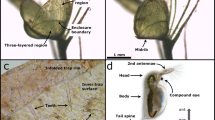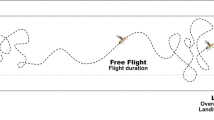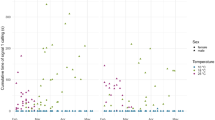Abstract
FEW records exist of insects with two peaks of activity in 24 hr. Of the many identified species attracted to a light in four years of continuous trapping, only one, a moth Pterophorus monodactylus, was caught at two separate times each night1. Aphis fabae has a double peak of emigrant flight from its secondary host, and this is the result of a complex chain of moulting rhythms, weather influences and flight behaviour2. A fall has been observed in the number of Simulium venustum in the air when evaporation-rate was high, leaving density maxima at 09.00 and 18.00 hr.3. Several species of Drosophilidae have been caught at bait traps with maximum numbers at dusk and dawn both in Europe and America4–6; but many factors, including humidity, will affect the area of influence of these traps and hence the number of insects caught and possibly their time of arrival.
This is a preview of subscription content, access via your institution
Access options
Subscribe to this journal
Receive 51 print issues and online access
$199.00 per year
only $3.90 per issue
Buy this article
- Purchase on Springer Link
- Instant access to full article PDF
Prices may be subject to local taxes which are calculated during checkout
Similar content being viewed by others
References
Williams, C. B., Trans. Roy. Ent. Soc. Lond., 89, 79 (1939).
Johnson, C. G., Biol. Rev., 29, 87 (1954).
Davies, D. M., Canad. J. Zool., 30, 287 (1952).
Dobzhansky, T., and Epling, C., Carnegie Inst. Wash., Pub. 554 (1944).
Pavan, C., Dobzhansky, T., and Burla, H., Ecology, 31, 36 (1950).
Hadorn, B., Burla. H., Gloor, H., and Ernst, F., Z. indukt. Abst. Verer., 84, 133 (1952).
Taylor, L. R., Ann. App. Biol., 38, 582 (1952).
Rendell, J. M., J. Genet., 46, 287 (1945).
Fingerman, M., and Brown, F. A., Science, 116, 171 (1952).
Lilleland, O., Biol. Bull. Woods Hole, 74, 314 (1938).
Author information
Authors and Affiliations
Rights and permissions
About this article
Cite this article
TAYLOR, L., KALMUS, H. Dawn and Dusk Flight of Drosophila subobscura Collin. Nature 174, 221–222 (1954). https://doi.org/10.1038/174221a0
Issue Date:
DOI: https://doi.org/10.1038/174221a0
This article is cited by
-
Tagesperiodik der Aktivit�t und der Orientierung nach Wald und Feld von Drosophila subobscura und Drosophila obscura
Zeitschrift f�r Vergleichende Physiologie (1967)
Comments
By submitting a comment you agree to abide by our Terms and Community Guidelines. If you find something abusive or that does not comply with our terms or guidelines please flag it as inappropriate.



